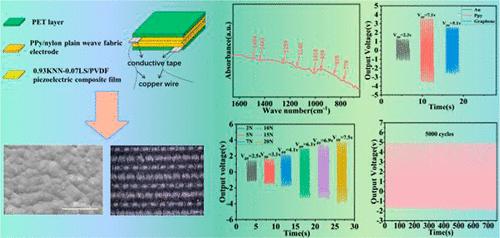当前位置:
X-MOL 学术
›
ACS Appl. Mater. Interfaces
›
论文详情
Our official English website, www.x-mol.net, welcomes your feedback! (Note: you will need to create a separate account there.)
Self-Powered Sensors Made with Fabric-Based Electrodes and a Conductive Coating
ACS Applied Materials & Interfaces ( IF 8.3 ) Pub Date : 2024-06-27 , DOI: 10.1021/acsami.4c04738 Wenping Cheng 1 , Jie Dong 1, 2 , Runjun Sun 1, 2
ACS Applied Materials & Interfaces ( IF 8.3 ) Pub Date : 2024-06-27 , DOI: 10.1021/acsami.4c04738 Wenping Cheng 1 , Jie Dong 1, 2 , Runjun Sun 1, 2
Affiliation

|
Amidst the growing challenge of meeting global energy demands with conventional sources, self-powered devices offer promising solution. Flexible and stretchable electronics are pivotal in wearable technology, enhancing the scope and functionality of these devices. This study employs potassium sodium niobite–lithium antimonate (K0.5Na0.5NbO3–LiSbO3) nanoparticles as fillers in polyvinylidene fluoride (PVDF) to fabricate piezoelectric thin films. These films are integrated with fabric-based electrodes to develop high-performance, flexible self-powered sensors. The sensor comprises a fabric-based electrode with polypyrrole (PPy) coated on plain nylon fabric, a 0.93KNN-0.07LS/PVDF composite piezoelectric thin film, and a protective PET layer. Results demonstrate that the 0.93KNN-0.07LS/PVDF–PPy/nylon composite sensors exhibit a stable piezoelectric output. Under 6 Hz and 10 N excitation, the piezoelectric output reaches approximately 6.1 V upon pressing. Additionally, the device shows good linear sensitivity in the 2–20 N pressure range and produces clear, regular output waveforms under cyclic pressures of varying frequencies and amplitudes, indicating excellent response repeatability. Even after extensive bending, twisting, and 5000 pressing cycles, the sensors maintain considerable cyclic stability, demonstrating high durability. These tests collectively indicate that the developed sensors possess high sensitivity, flexibility, durability, stability, and significant self-powered potential. This research provides a reference for the next generation of textile-based electrodes and offers potential strategies for flexible, wearable applications.
中文翻译:

采用织物电极和导电涂层制成的自供电传感器
在利用传统能源满足全球能源需求的挑战日益严峻的情况下,自供电设备提供了有前途的解决方案。灵活且可拉伸的电子产品在可穿戴技术中至关重要,它增强了这些设备的范围和功能。本研究采用铌酸钾钠-锑酸锂(K 0.5 Na 0.5 NbO 3 –LiSbO 3 )纳米颗粒作为聚偏二氟乙烯中的填料(PVDF)用于制造压电薄膜。这些薄膜与基于织物的电极集成,以开发高性能、灵活的自供电传感器。该传感器由涂覆在普通尼龙织物上的聚吡咯(PPy)织物电极、0.93KNN-0.07LS/PVDF 复合压电薄膜和保护性 PET 层组成。结果表明,0.93KNN-0.07LS/PVDF-PPy/尼龙复合传感器表现出稳定的压电输出。在 6 Hz 和 10 N 激励下,按下时压电输出达到约 6.1 V。此外,该器件在 2–20 N 压力范围内表现出良好的线性灵敏度,并在不同频率和幅度的循环压力下产生清晰、规则的输出波形,表明具有出色的响应重复性。即使经过大量弯曲、扭转和 5000 次按压循环后,传感器仍保持相当大的循环稳定性,表现出高耐用性。这些测试共同表明,所开发的传感器具有高灵敏度、灵活性、耐用性、稳定性和显着的自供电潜力。这项研究为下一代基于织物的电极提供了参考,并为灵活的可穿戴应用提供了潜在的策略。
更新日期:2024-06-27
中文翻译:

采用织物电极和导电涂层制成的自供电传感器
在利用传统能源满足全球能源需求的挑战日益严峻的情况下,自供电设备提供了有前途的解决方案。灵活且可拉伸的电子产品在可穿戴技术中至关重要,它增强了这些设备的范围和功能。本研究采用铌酸钾钠-锑酸锂(K 0.5 Na 0.5 NbO 3 –LiSbO 3 )纳米颗粒作为聚偏二氟乙烯中的填料(PVDF)用于制造压电薄膜。这些薄膜与基于织物的电极集成,以开发高性能、灵活的自供电传感器。该传感器由涂覆在普通尼龙织物上的聚吡咯(PPy)织物电极、0.93KNN-0.07LS/PVDF 复合压电薄膜和保护性 PET 层组成。结果表明,0.93KNN-0.07LS/PVDF-PPy/尼龙复合传感器表现出稳定的压电输出。在 6 Hz 和 10 N 激励下,按下时压电输出达到约 6.1 V。此外,该器件在 2–20 N 压力范围内表现出良好的线性灵敏度,并在不同频率和幅度的循环压力下产生清晰、规则的输出波形,表明具有出色的响应重复性。即使经过大量弯曲、扭转和 5000 次按压循环后,传感器仍保持相当大的循环稳定性,表现出高耐用性。这些测试共同表明,所开发的传感器具有高灵敏度、灵活性、耐用性、稳定性和显着的自供电潜力。这项研究为下一代基于织物的电极提供了参考,并为灵活的可穿戴应用提供了潜在的策略。






































 京公网安备 11010802027423号
京公网安备 11010802027423号